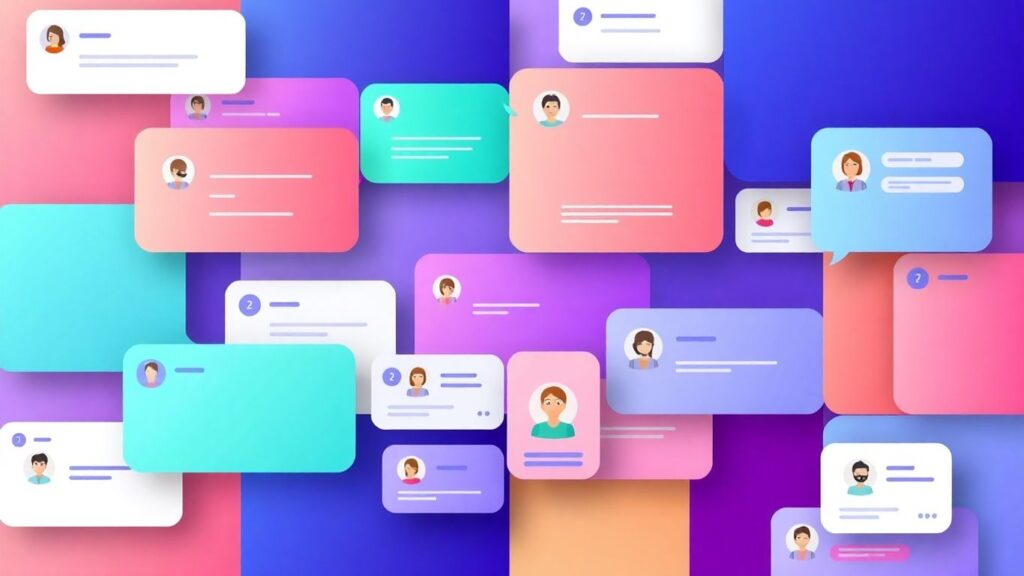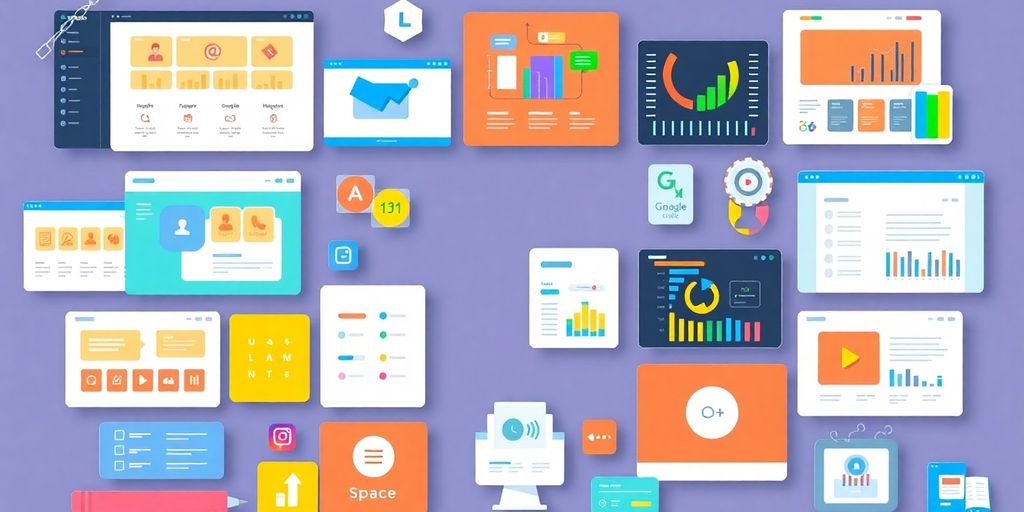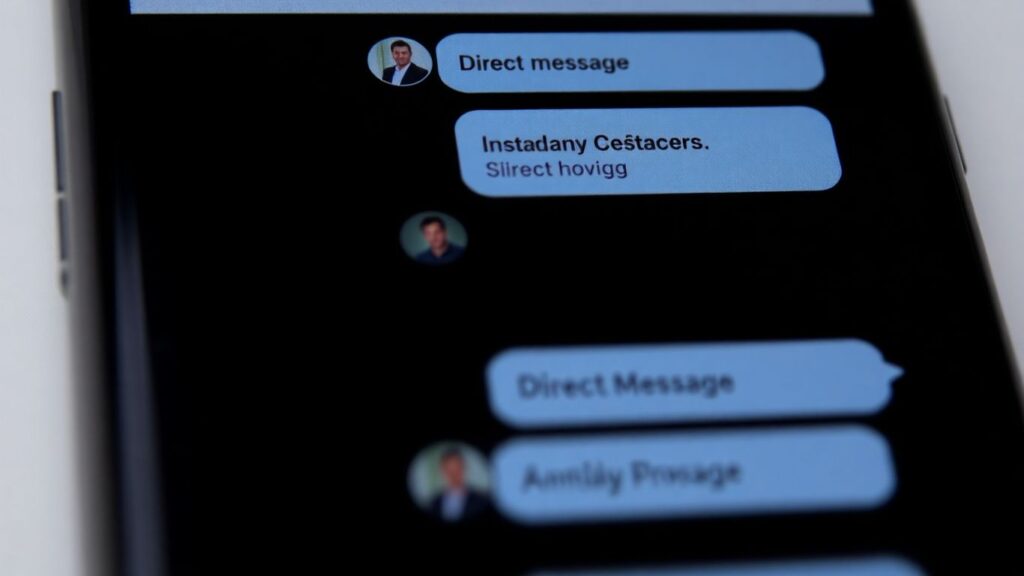manychat alternatives

Manychat has been a go-to for businesses wanting to automate messages on platforms like Instagram and Facebook. It’s pretty straightforward and can get a lot done, especially for marketing. But, like anything, it’s not always the perfect fit for every single business out there. Maybe you’re hitting its limits, need more advanced AI, or just want to explore different options. That’s totally fine! There are actually a bunch of solid manychat alternatives that offer different strengths. I’ve looked into a bunch of them, and this guide will walk you through some of the best ones you should be checking out, whether you need something simpler, more powerful, or just different.
Key Takeaways
- When looking for manychat alternatives, consider what you really need. Do you want better AI, support for more channels, or a simpler interface?
- Chatfuel is a strong contender, offering similar features to Manychat but with a bigger focus on AI and supporting more platforms like WhatsApp.
- If you need to manage conversations across many different channels all in one place, Customer.AI (formerly MobileMonkey) is worth a look for its omnichannel approach.
- For businesses that want a lot of control and customizability, especially with AI support, Botpress is a powerful option, though it might require more technical know-how.
- When choosing a platform, think about your budget, how easy it is for your team to use, and if it can grow with your business. Don’t just pick the first thing you see.
Exploring Top ManyChat Alternatives

So, you’ve been using ManyChat for your business, and maybe it’s time to see what else is out there. It’s a solid tool, no doubt, especially if you’re focused on platforms like Instagram and Facebook Messenger. But sometimes, you just need something… more. Maybe you’re looking for smarter AI, a way to connect with customers across more channels, or just a different way of doing things. The good news is, there are some really interesting options available that can do what ManyChat does, and then some. Let’s take a look at a few of the standouts.
Chatfuel: Advanced AI and Multi-Platform Support
Chatfuel is often mentioned when people talk about ManyChat alternatives, and for good reason. It’s known for its more advanced AI capabilities, which can make your chatbot conversations feel a bit more natural and less robotic. If you’re aiming for more sophisticated interactions or need to manage bots across Facebook, Instagram, and even WhatsApp, Chatfuel has got you covered. It also offers robust analytics, so you can actually see what’s working and what’s not. The downside? It can have a bit of a steeper learning curve compared to ManyChat. If you’re willing to put in a little extra time to learn, though, the payoff in terms of conversational power can be significant.
Customer.AI: The Omnichannel Champion
Customer.AI, formerly known as Mobile Monkey, is another strong contender, especially if you’re thinking beyond just Facebook and Instagram. This platform really shines when it comes to being omnichannel. What that means is it helps you unify your customer conversations across different channels – think SMS, web chat, and of course, Facebook Messenger – all in one place. They have this thing called Registered OmniChat technology that’s supposed to make managing that unified inbox easier. If lead generation is a big part of your strategy, Customer.AI also packs tools specifically designed for that. They even have a library of templates, similar to ManyChat, to get you started quickly.
Botpress: Customizable AI Support Chatbots
Now, Botpress is a bit different. It’s geared towards businesses that want a high degree of customization and control over their AI chatbots. While it offers a visual editor, getting the most out of it often involves a bit of coding. This makes it a fantastic choice if you have technical folks on your team or if you’re looking to build a very specific, tailored AI solution. It’s less of a plug-and-play option and more of a platform you can really build on. If you need deep control over your chatbot’s logic and integrations, and you have the resources to invest, Botpress is definitely worth a close look. It’s ideal for creating custom AI support bots that can handle complex queries.
Key Features to Consider in Alternatives
When you’re looking at other options besides ManyChat, it’s easy to get lost in all the bells and whistles. But really, you just need to focus on what actually matters for your business. Think about what you need the chatbot to do and how it needs to fit into your existing setup. Don’t get swayed by fancy features you’ll never use.
Advanced Automation and Workflow Customization
This is where things get interesting. ManyChat has its own way of building flows, but some alternatives let you get way more granular. You might need complex branching logic, conditional triggers based on user behavior, or the ability to pass data between different parts of your conversation. Look for platforms that offer a visual builder that’s flexible enough for your needs, or even scripting options if you have someone on your team who can handle that.
- Conditional Logic: Can the bot respond differently based on user input or previous actions?
- API Integrations: Does it allow custom actions or data retrieval from external systems?
- Tagging and Segmentation: How well can you tag users and segment them for targeted follow-ups?
- A/B Testing: Can you test different conversation flows to see which performs better?
The goal here is to create conversations that feel natural and helpful, not robotic. If a platform makes it hard to set up the exact logic you need, it’s going to cause headaches down the line.
Integration Capabilities with Business Tools
Your chatbot isn’t an island. It needs to talk to your other software. Think about your CRM, your email marketing service, your calendar, or even your inventory system. The best alternatives will connect smoothly with the tools you already use. This means less manual data entry and more automated processes. Check if they have built-in integrations or if they work with tools like Zapier or Make (formerly Integromat) to bridge the gaps.
Here’s a quick look at common integration needs:
- CRM: Sync contact info and conversation history (e.g., HubSpot, Salesforce).
- Email Marketing: Add subscribers to lists or trigger campaigns (e.g., Mailchimp, ActiveCampaign).
- E-commerce: Update order status, capture product interest (e.g., Shopify, WooCommerce).
- Calendar: Book appointments directly (e.g., Calendly, Google Calendar).
User-Friendliness for Non-Technical Teams
This is a big one. If your marketing or support team doesn’t have a developer on staff, you need a platform that’s easy to pick up. A drag-and-drop interface is usually a good sign. Look for clear documentation and tutorials. It should feel intuitive, not like you need a computer science degree to build a simple welcome message. If the learning curve is too steep, your team might just end up not using it effectively, or at all.
Consider these points:
- Visual Flow Builder: Is it easy to see and edit the conversation path?
- Pre-built Templates: Are there templates to get you started quickly?
- Clear Interface: Is the dashboard organized and easy to navigate?
- Support Resources: Are there helpful guides, videos, or a community forum?
If a platform feels overly complicated from the start, it’s probably not the right fit for a team that needs to get things done without a lot of technical fuss.
Evaluating Chatbot Platform Pricing Models

When you’re looking at different chatbot tools, figuring out the pricing can feel like a puzzle. It’s not just about the sticker price; you’ve got to think about what you actually get for your money and how it fits your budget now and later.
Understanding Free and Paid Plan Structures
Most chatbot platforms offer a free tier, which is great for testing the waters. These usually come with pretty basic features – maybe a limited number of chats per month or fewer automation options. It’s a good way to get a feel for the interface and see if it does what you need without spending a dime. Paid plans, on the other hand, unlock the real power. They typically offer more advanced features like complex workflow customization, deeper analytics, priority support, and integrations with more business tools. You’ll often see tiered pricing, where each level up gives you more of everything – more chatbots, more monthly messages, more team members, and access to premium features.
Cost-Effectiveness for Small Businesses
For small businesses, every dollar counts. You want a tool that provides a good return on investment. Look for platforms that offer a solid free plan or a low-cost entry-level paid plan that still gives you enough functionality to make a difference. Some platforms are priced per chatbot, while others charge based on the number of contacts or messages. It’s important to choose a model that aligns with your current customer volume and growth projections. Don’t get locked into a plan that’s way more than you need right now, but also make sure there’s room to grow without a massive price jump.
Scalable Pricing for Growing Enterprises
As your business expands, your chatbot needs will likely change. You’ll want a platform that can grow with you. Scalable pricing means the cost increases gradually as you use more features or handle more volume. This often looks like higher tiers with more advanced capabilities, dedicated support, or custom solutions for large-scale deployments. Some platforms even offer custom enterprise plans where you work directly with their sales team to build a package that fits your unique requirements. This ensures you’re not overpaying for features you don’t use, but you have access to everything you need as your business scales up.
Here’s a quick look at how some plans might stack up:
| Plan Name | Price (Monthly) | Key Features |
|---|---|---|
| Free | $0 | Basic features, limited chats |
| Starter | $29 – $52 | More chats, basic integrations, 1-2 chatbots |
| Pro/Business | $89 – $142 | Advanced features, more chatbots, team access |
| Enterprise | Custom | Unlimited features, dedicated support, custom AI |
When evaluating pricing, always consider the total cost of ownership. This includes not just the monthly subscription but also any setup fees, integration costs, or potential charges for exceeding message limits. A slightly higher monthly fee might be more cost-effective if it includes features that save you significant time or generate more revenue.
Specific Use Cases for Chatbot Platforms
Chatbot platforms aren’t just for fancy tech companies anymore. They’re tools that can really help out businesses of all sizes, especially when you know how to use them. Think about it – automating tasks, talking to customers, and even making sales can all happen through a chatbot. It’s about making things easier for you and for the people you serve.
E-commerce Automation and Lead Capture
For online stores, chatbots are like having an extra salesperson working 24/7. They can help customers find what they’re looking for, answer questions about products, and even help with checkout. A really cool trick is recovering abandoned carts. You know, when someone adds stuff to their cart but then leaves? A chatbot can send a friendly reminder, maybe with a small discount, to bring them back. It’s also great for grabbing leads. A bot can ask visitors questions like what they’re interested in or their budget, and then pass that info along to your sales team. This means your team spends less time on people who aren’t serious and more time on actual potential buyers.
Customer Support and Engagement Tools
Nobody likes waiting on hold, right? Chatbots can handle a lot of common customer questions instantly. Think FAQs about shipping, returns, or how to use a product. This frees up your human support staff to deal with the really tricky problems. Beyond just answering questions, chatbots can keep customers engaged. They can send out updates about new products, special offers, or even just check in to see how things are going. It’s a way to stay connected without being annoying.
Instagram and Facebook Messenger Marketing
These platforms are huge for reaching people, and chatbots are a natural fit. You can use them to run contests, send out special deals directly to people’s inboxes, or even guide them through a purchase without them ever leaving the app. Imagine someone comments on your Instagram post, and a bot automatically messages them with more info or a link to buy. It makes the whole process super smooth. This kind of direct, automated communication can seriously boost your sales and build a stronger connection with your audience.
Chatbots can be programmed to remember past conversations and preferences, making each interaction feel more personal. This isn’t just about sending messages; it’s about building relationships at scale.
Emerging Trends in Chatbot Technology
The world of chatbots is changing fast, and a couple of big things are happening right now that you should know about. It’s not just about simple automated replies anymore; things are getting smarter and more accessible.
The Rise of Voice-Enabled Chatbots
Voice is becoming a much bigger deal. Think about how often you use voice commands on your phone or smart speaker. Chatbots are catching up. Soon, you’ll be able to talk to bots just like you talk to a person. This makes things easier for everyone, especially people who find typing difficult or are busy doing other things. It’s all about making interactions smoother and quicker. We’re seeing platforms start to build this in, and it’s expected to grow quite a bit in the next year or so.
Dominance of No-Code Chatbot Solutions
Remember when building software meant you had to be a coding wizard? Well, that’s changing for chatbots too. No-code platforms are becoming super popular. This means you don’t need to know how to program to create a pretty advanced chatbot. You can usually drag and drop different pieces to build your conversation flow. This is a huge win for small businesses or teams that don’t have dedicated tech people. It really opens up the door for more people to use this technology.
AI-Driven Customer Interaction
Artificial intelligence is really the engine behind a lot of these new trends. Chatbots are getting much better at understanding what people are actually saying, not just keywords. They can figure out the intent behind a question and respond in a way that feels more natural. This means fewer frustrating loops and more helpful conversations. The goal is to make the interaction feel less like talking to a machine and more like getting help from someone who understands.
The focus is shifting from just automating tasks to creating genuinely helpful and personalized experiences. This means bots need to understand context, remember past interactions, and adapt their responses accordingly. It’s about building relationships, not just processing requests.
Making the Right Choice: ManyChat vs. Competitors
So, you’ve been using ManyChat, and maybe it’s time to see if there’s something else out there that fits your business better. It’s not always about ManyChat being bad; sometimes, it’s just that your needs have changed, or you’ve discovered features in other tools that seem more aligned with where you want to go. Let’s break down when sticking with ManyChat makes sense and when it might be time to explore other options.
When to Stick with ManyChat
ManyChat really shines for businesses that are just getting their feet wet with chatbots or those heavily focused on social media marketing. If your primary channels are Facebook Messenger and Instagram, and you value a straightforward setup, ManyChat is a solid choice. It’s known for being user-friendly, which means you can get a basic bot up and running without needing a degree in computer science. Plus, its pricing is generally quite accessible, making it a good starting point for smaller operations or those on a tighter budget.
- Simplicity: Easy to learn and use, even for beginners.
- Social Media Focus: Excellent for Facebook Messenger and Instagram automation.
- Affordability: Often more budget-friendly for basic needs.
When to Consider a Switch
However, if you’re finding ManyChat a bit limiting, it might be time to look around. This often happens when you need to expand beyond just Facebook and Instagram, perhaps integrating with your website’s live chat or diving deep into SMS campaigns. Maybe you’re looking for more sophisticated AI capabilities to handle complex customer queries, or you need robust analytics to really understand what your bots are doing. If your business is growing and requires more advanced workflows or integrations with other business tools like CRMs or email marketing platforms, then exploring alternatives is a smart move.
Here are a few scenarios where a switch might be beneficial:
- Omnichannel Needs: You need to manage conversations across multiple platforms (website, SMS, WhatsApp, email) from a single inbox.
- Advanced Automation: You require more complex branching logic, custom coding options, or deeper workflow customization.
- Deeper Analytics: You need more detailed reporting on bot performance, customer interactions, and ROI.
- Specific Integrations: You rely heavily on integrations with specific CRMs, e-commerce platforms, or other business software that ManyChat doesn’t support well.
Aligning Platform Choice with Business Goals
Ultimately, the best platform isn’t just about features; it’s about how well it helps you achieve your specific business objectives. Think about what you’re trying to accomplish. Are you trying to capture more leads? Improve customer support response times? Drive sales through automated product recommendations? Different platforms excel in different areas.
Choosing a chatbot platform is a strategic decision. It’s not just about picking the tool with the most bells and whistles, but the one that best supports your current operations and future growth plans. Consider your team’s technical skills, your budget, and the primary channels where your audience interacts with you.
For instance, if your main goal is to automate customer support for an e-commerce store, a platform with strong integration with Shopify and advanced order tracking features might be ideal. If you’re a small business owner looking to quickly engage visitors on your website, a simpler live chat solution with basic bot capabilities could be perfect. Always map the platform’s strengths against your most important business goals.
Best ManyChat Alternatives for Specific Needs
So, you’ve been using ManyChat and it’s been… fine. But maybe you’re hitting a wall, or perhaps you’re just curious about what else is out there. It’s totally normal to look around, especially when your business grows or your needs change. Let’s break down some of the top contenders and see who’s best suited for what.
Best for AI Beginners: Chatbase
If you’re new to the whole chatbot scene and want something that feels intuitive, Chatbase is a solid pick. It’s designed to make AI chatbots accessible without making you feel like you need a computer science degree. You can get a basic bot up and running pretty quickly.
- Easy setup: You can train your bot with your own data, like website content or documents.
- Good for learning: It’s a great way to experiment with AI chatbots without a huge commitment.
- Affordable start: They have a free plan, and paid plans are quite reasonable if you need more.
Chatbase really shines when you want to add a smart chatbot to your website that can answer questions based on your specific content.
Best for Omnichannel Chatbots: UChat
Need to be everywhere at once? UChat is built for that. If you’re juggling Facebook Messenger, Instagram, WhatsApp, and even SMS, this platform aims to bring it all together. It’s about managing conversations across different channels from one spot.
- Unified Inbox: See messages from all your channels in one place.
- Multi-channel support: Works with Facebook, Instagram, WhatsApp, SMS, and more.
- Flexible pricing: Starts with a free plan and has affordable paid options.
UChat is a good choice if you’re tired of switching between different apps to talk to your customers on various platforms. It tries to simplify that whole process.
Best for WhatsApp Integration: Wati
WhatsApp is a massive platform, and if that’s where your customers are, Wati is worth a serious look. It’s built with WhatsApp in mind, offering tools specifically for that channel. Think about sending broadcasts, managing customer chats, and automating messages, all within the WhatsApp ecosystem.
- WhatsApp focused: Tools are tailored for the WhatsApp Business API.
- Broadcasts and campaigns: Send messages to your customer lists.
- CRM features: Helps manage customer interactions.
Wati is a strong contender if your primary goal is to build a robust presence and automate interactions specifically on WhatsApp. It’s not just an add-on; it’s built around it.
So, What’s the Verdict?
Alright, so we’ve looked at a bunch of different options out there that can do what Manychat does, and sometimes even more. Manychat is a solid tool, especially if you’re just getting started with automating messages on platforms like Instagram or Facebook, and you like things simple. But, if your business is growing, or you need something a bit more specific – maybe better AI, more ways to connect with customers across different apps, or just a different price point – then checking out these alternatives makes a lot of sense. The best choice really just depends on what you need right now and what you plan to do down the road. Don’t just pick one because it’s popular; pick the one that actually helps your business do its thing.
Frequently Asked Questions
What are the best ManyChat alternatives for Instagram?
Some top choices for Instagram include Chatfuel, which is similar to ManyChat but with more smart features. Chatbase is great if you’re just starting with AI. UChat is a good pick for managing chats across many places at once. Wati is a solid all-around option, especially for WhatsApp. And Botpress is perfect if you want to build super custom AI chatbots for customer help.
Is Chatfuel better than ManyChat?
Chatfuel and ManyChat are pretty alike, especially for Facebook and Instagram. Chatfuel has a better connection to ChatGPT, which is a powerful AI. ManyChat is a bit easier to use and has a smoother way to build conversations. If you want things simple, ManyChat is good. But if you want smarter AI, Chatfuel is the way to go.
What’s not so great about ManyChat?
ManyChat’s main downsides are its limited AI smarts and the fact that you have to build messages separately for each platform like Instagram and Facebook. It doesn’t have a really advanced AI system for customer service. It’s good for marketing, but not the best if you need smart customer support.
Does Instagram have problems with ManyChat?
No, Instagram actually works well with ManyChat. ManyChat is an official partner with Meta (the company that owns Instagram). It’s good for automating direct messages, replies to stories, and comments. Just make sure your Instagram account follows Meta’s rules for using automation.
Which is better, ManyChat or LinkDM?
LinkDM is more focused on tools to help your Instagram messages grow. ManyChat is a bigger tool that can automate messages in many ways and connect with different platforms. ManyChat is a better choice if you need full automation and want to use it on more than just Instagram. But if you only care about getting more Instagram followers through direct messages, LinkDM might work for you.
What else can I use instead of ManyChat?
There are many good options besides ManyChat, depending on what you need. Chatfuel is very similar but has better AI. Chatbase is excellent for AI features, especially if you’re new to them. UChat is great for handling messages from many different places. And Wati is a strong choice for WhatsApp users.







Responses